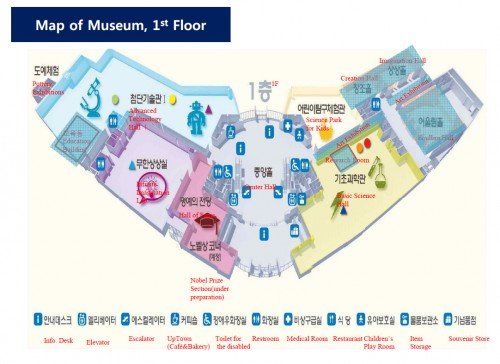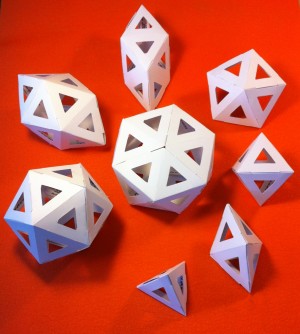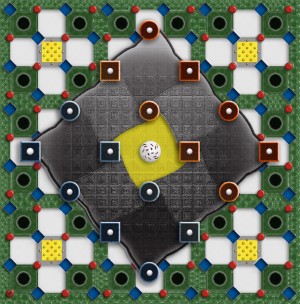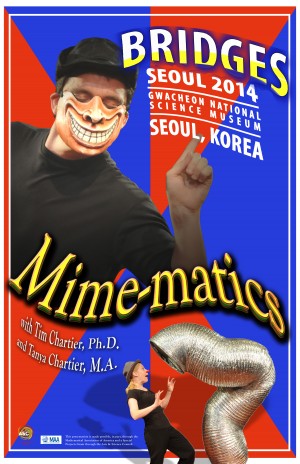Bridges Seoul 2014
FAMILY DAY & MATH-ART EXPO
Coordinated by Kristóf Fenyvesi, PhD
Director of Community Events, Bridges Organization
E-mail: familyday@bridgesmathart.org, Phone: +358-40-805-3324
Saturday, 16 August, 2014, Seoul, Korea
Gwacheon National Science Museum (국립과천과학관)
- Bridges Math-Art Workshops, 10:00-6:30 PM at various locations
- Short Movie Festival (curated by Robert Bosch), 10:30-11.30 AM and 3:30-5:00 PM at Eoullim Hall
- Mime-Matics (Tim and Tanya Chartier), 11:30-12.10 PM and 5:00-5:40 (with Korean translation) at Eoullim Hall
- Math and Dance (Karl Schaffer, Erik Stern, and Saki – with Korean translation) 2:00-3:30 PM at Eoullim Hall
- Poetry and Music Night (coordinated by Sarah Glaz and hosted by Mike Naylor), 6:30 – 8:00 PM at Eoullim Hall
- Jardin Galerie’s Children and Youth Art Exhibit (curated by John Hiigli and Kristóf Fenyvesi), 10:30-6:30 PM
1. Bridges Math-Art Workshops, 10:00-6:30 PM
10:00-10:30 AM, Bridges Seoul Registration Desk: REGISTRATION TO
- International ZonoDome Workshop
- Fun Origami
- Completing an Escher-Like Two Color Tessellation Vinyl Sticker
- Line Drive
- The Shortest Route Problem
10:00-5:00 PM, Creation Hall: International ZonoDome Workshop
by Zometool Inc. (Paul Hildebrant – Zometool, Chester Kim – Rootuit, and Helen Yu – TWeducare)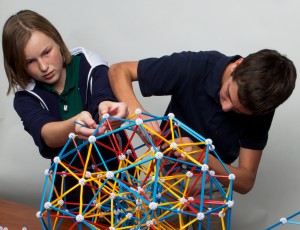 An indoor workshop along with a design contest to boost your creativity!
An indoor workshop along with a design contest to boost your creativity!
Program:
10:00-10:30 Registration
10:30-12:30 Zometool workshop
12:30-2:00 Lunch break
2:00-4:30 Design Contest
4:30-5:00 Award/Prize Giving and Group Photos
5:00-5:30 Clean-up
2:00 – 5:00 PM, Imagination Hall: Fun Origami
by Sejin Park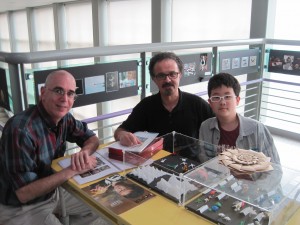 Sejin Park, 14 year old Korean origami artist will teach you how to make simple origami models, which can be folded in 5-10 minutes. Sejin Park’s works were displayed at: Surface to Structure (Cooper Union Gallery NYC, US, 2014), Sejin’s Passion of Origami (Seoul National University of Education, Korea, 2012), Children’s Museum of the Arts NYC, US, 2012). His 3 origami models are on display at Bridges 2014 Math-Art Exhibit.
Sejin Park, 14 year old Korean origami artist will teach you how to make simple origami models, which can be folded in 5-10 minutes. Sejin Park’s works were displayed at: Surface to Structure (Cooper Union Gallery NYC, US, 2014), Sejin’s Passion of Origami (Seoul National University of Education, Korea, 2012), Children’s Museum of the Arts NYC, US, 2012). His 3 origami models are on display at Bridges 2014 Math-Art Exhibit.
2:00-4:00 PM, Imagination Hall: Harmony of Pentagons and Hexagons
by Ho Gul Park, www.4dframe.com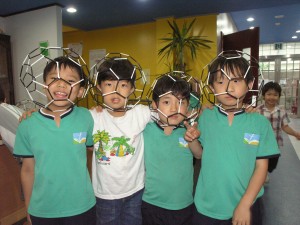 We make a soccer ball which has 12 pentagons and 20 hexagons and can also be explained as a truncated icosahedron. This activity will contribute to the better understanding of difficult mathematical concepts and structures.
We make a soccer ball which has 12 pentagons and 20 hexagons and can also be explained as a truncated icosahedron. This activity will contribute to the better understanding of difficult mathematical concepts and structures.
Simple explanations and a lot of fun for children!
2:00 – 6:30 PM, Imagination Hall: Star Cage Geometric Zoo
by Akio Hizume, www.starcage.org
In this workshop you can study several examples of architecture and music based on the Golden Ratio and quasi-periodicity.
2:00 – 6:00 PM, Imagination Hall: Play with the building blocks of the Universe!
by Renate Quehenberger, http://quantumcinema.uni-ak.ac.at/
 The newly discovered epitahedron is a 3D representation of the Penrose Kites and Darts, and it is a cell of a 5-dimensional space, where photons and particles ‘live’. We will investigate epitahedron’s complex intersecting space configurations by playing with a newly developed 3D puzzle. The building blocks of this puzzle allow us to create a variety of different shapes. We will start with only a dodecahedron, a pentagonal pyramid and a tetrahedron to form two intersecting epitahedra – also shown in the BRIDGES Mathematical Art Gallery. By augmenting more modules we will achieve to build a stellated dodecahedron, the great dodecahedron, and finally the icosahedron,- and more?
The newly discovered epitahedron is a 3D representation of the Penrose Kites and Darts, and it is a cell of a 5-dimensional space, where photons and particles ‘live’. We will investigate epitahedron’s complex intersecting space configurations by playing with a newly developed 3D puzzle. The building blocks of this puzzle allow us to create a variety of different shapes. We will start with only a dodecahedron, a pentagonal pyramid and a tetrahedron to form two intersecting epitahedra – also shown in the BRIDGES Mathematical Art Gallery. By augmenting more modules we will achieve to build a stellated dodecahedron, the great dodecahedron, and finally the icosahedron,- and more?
4:30 – 6:30 PM, Imagination Hall: Playful Geometry: Creating 3D Polyhedral Structures from Innovative 2D Self-assembling Paper Folding Units
by Tamir Ashman, www.octafold.com
Workshop participants create a world of shapes and structures on the basis of a unique paper-unit. We experience the folding and unfolding movement of a 2D paper unit into 3D polyhedral structures in a simple, easy way and get acquainted with a few fundamental polyhedra that are significant to our life and nature.
2:00 – 4:00 PM, Imagination Hall: Completing an Escher-Like Two Color Tessellation Vinyl Sticker
by Kevin Lee, www.tesselmaniac.com
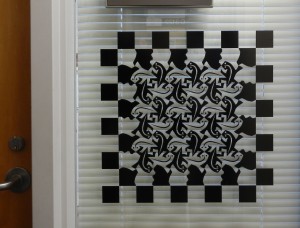 Once a vinyls sticker is cut on a vinyl cutter the sticker needs to be ’weeded’ which means carefully removing that vinyl that is not part of the design. For a two color tessellation, the pieces for the second color need to be removed. The participant will be weed a vinyl sticker following a tessellation design. After weeding, a special transfer tape will be applied which will allow the participant to transfer the decal to a surface of their choice. Participants will have a 20cm x 20cm tessellation sticker to take home.
Once a vinyls sticker is cut on a vinyl cutter the sticker needs to be ’weeded’ which means carefully removing that vinyl that is not part of the design. For a two color tessellation, the pieces for the second color need to be removed. The participant will be weed a vinyl sticker following a tessellation design. After weeding, a special transfer tape will be applied which will allow the participant to transfer the decal to a surface of their choice. Participants will have a 20cm x 20cm tessellation sticker to take home.
2:00 – 6:00 PM, Imagination Hall: Line Drive
by Emily Panasowich, Destination Imagination, www.destinationimagination.org
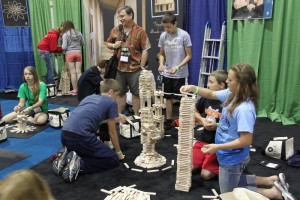 The particpants will get a set of common household materials and they will be asked to create a device that attaches to a zip line and carries a ball as far down the zip line as possible. The particpants will use basic mathematical concepts to engineer and build their device. The activity also involves: problem solving, creativity and critical thinking, team work, innovation and communication.
The particpants will get a set of common household materials and they will be asked to create a device that attaches to a zip line and carries a ball as far down the zip line as possible. The particpants will use basic mathematical concepts to engineer and build their device. The activity also involves: problem solving, creativity and critical thinking, team work, innovation and communication.
3:00 – 6:00 PM, Imagination Hall: Jomili Madness
by Jomili Team, http://jomilicubes.eu/
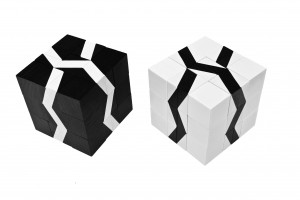 The Jomili Cubes is a set of black and white wooden cubes. Suitable for all ages as a game or demonstration tool for 2D patterns and 3D shapes. Excellent for developing hands-on and spatial skills, logical and creative thinking.
The Jomili Cubes is a set of black and white wooden cubes. Suitable for all ages as a game or demonstration tool for 2D patterns and 3D shapes. Excellent for developing hands-on and spatial skills, logical and creative thinking.
2:00 – 6:00 PM, Imagination Hall: Quilt fun with √4 and √5
by Elaine Krajenke Ellison, www.mathematicalquilts.com 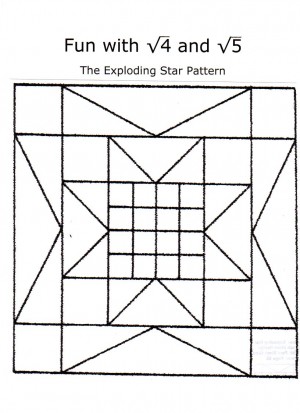
Each participant will be given a 2-sided tag board pattern. The mathematics of the quilt pattern will be shown on one side of the paper. The second side will have quilt the pattern without any color. The participants will cut colored paper or sticky glitter foam patterns out and stick the pieces to the paper. The colors will be attached to the blank template. A beautiful mathematical design will be created!
3:30 – 5:00 PM, Lecture Room II, Education Hall: The Shortest Route Problem
by Jean Constant, Hermay.org
Stochastic processes are associated with concepts of uncertainty or chance. They are a major focus of studies in various scientific disciplines such as Mathematics, Statistics, Finance, Artificial Intelligence/Machine Learning and Philosophy. Visual arts too depend on elements of uncertainly and chance. Participants will be challenged to use computer graphic tools rather than abstract number calculation to show how to solve a classic Graph theory problem called “The Shortest Route Problem”. They will be given a black and white template outline of the problem, select their own palette of shapes and colors and highlight the reasoning and progression steps needed to find the solution. The instructor will give a brief overview of the Visual Communication environment, the software available for the workshop, and guide the students through the image making process. No in-depth knowledge of computer graphic programs is needed.
3:00 – 5:00 PM, Imagination Hall: World Sierpinski Carpet
by José L. Rodríguez and David Crespo, http://topologia.wordpress.com
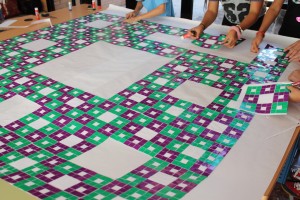 The Sierpinski carpet is a fractal published by the Polish mathematician Waclaw Sierpinski in 1916. Its’ construction is simple: start with a square, divide it in 9 equal squares and take out the central one; then, iterate this process in each of the 8 remaining squares, and continue infinitely many times. This produces a self-similar object, with zero area, but infinite perimeter. Nowadays, these kind of fractals are used to design heat sinks, receptors, and computer chips. In this activity, 64 children will make the 4th iteration of size 1,62 meters, by pasting stickers on a template. The 5th iteration can be made by 64*8= 512 children, and needs a squared extension of side 4,86 meters. A step further, the 6th iteration of 14,58 meters, will be made by 64 schools, involving 4096 children around the world. This huge carpet will be mounted in Barcelona (Spain), on October 4th, 2014. The carpet built in Bridges 2014 will be the number 64, the closing of the 6th iteration. A further challenge is to build the 7th iteration of almost 45 meters, involving 512 schools around the world, perhaps we can get it in 2016?
The Sierpinski carpet is a fractal published by the Polish mathematician Waclaw Sierpinski in 1916. Its’ construction is simple: start with a square, divide it in 9 equal squares and take out the central one; then, iterate this process in each of the 8 remaining squares, and continue infinitely many times. This produces a self-similar object, with zero area, but infinite perimeter. Nowadays, these kind of fractals are used to design heat sinks, receptors, and computer chips. In this activity, 64 children will make the 4th iteration of size 1,62 meters, by pasting stickers on a template. The 5th iteration can be made by 64*8= 512 children, and needs a squared extension of side 4,86 meters. A step further, the 6th iteration of 14,58 meters, will be made by 64 schools, involving 4096 children around the world. This huge carpet will be mounted in Barcelona (Spain), on October 4th, 2014. The carpet built in Bridges 2014 will be the number 64, the closing of the 6th iteration. A further challenge is to build the 7th iteration of almost 45 meters, involving 512 schools around the world, perhaps we can get it in 2016?
2. Short Movie Festival (curated by Robert Bosch), 10:30-11.30 AM and 3:30-5:00 PM at Eoullim Hall
The 5th Annual Bridges Short Movie Festival includes a variety of juried and curated videos and short films. The program includes movies, videos and animations that have been created for educational, corporate and artistic purposes, and will provide another opportunity for you to experience innovative and integrative techniques in the fields of mathematics and art. More artists and educators than ever are using movies, videos, and animations for different purposes ranging from education, industry, and art. To further the Bridges Organization objectives, we continue our efforts to introduce participants to innovative and integrative techniques in the fields of mathematics and art. A relatively new venue in this regard is The Bridges Short Movie Festival.
The Bridges Short Movie Festival is coordinated by award-winning artist and author, Robert Bosch, a Professor of Mathematics at Oberlin College, Ohio, USA.
3. Mime-Matics (Tim and Tanya Chartier), 11:30-12.10 PM and 5:00-5:40 (with Korean translation) at Eoullim Hall
Tim and Tanya Chartier’s mime combines masks, puppetry, and classical mime illusions into a distinctive style that they have performed throughout the United States and in national and international settings. The Chartiers have trained at Le Centre du Silence mime school, the Dell’Arte School of International Physical Theater and with the world-renowned mime artist Marcel Marceau.
Dr. Tim Chartier is a professor of mathematics and computer science at Davidson College, North Carolina USA. This past January, he was named the inaugural Math Ambassador for the Mathematical Association of America, an organization that also recognized Tim’s ability to communicate math both in the classroom and through mime to the broader community with a national teaching award. His research and scholarship were recognized with an Alfred P. Sloan Research Fellowship. Published by Princeton University Press, Tim wrote Math Bytes, an engaging book where, among various things, you can learn Calculus with m&ms. Tim fields mathematical questions for the Sports Science program on ESPN, and has also been a resource for a variety of media inquiries, which include appearances with NPR, the CBS Evening News, USA Today, and The New York Times. Please see an article, “Envisioning the Invisible”, that Dr. Chartier, wrote on mime and math for Notices of the AMS.
Tanya Chartier has been in the field of K-12 education for 20 years. Between her undergraduate studies in English Literature at Denison University and graduate studies in the Teaching of Reading at Western Michigan University, Tanya studied literacy in Japan as a Fulbright Fellow. Since then her experiences have run the gamut from classroom teacher, reading specialist, theatre teacher, and diagnostician for reading disabilities. In addition, Tanya has taught in the Education Department at Davidson College.
4. Math and Dance (Karl Schaffer, Erik Stern, and Saki – with Korean translation) 2:00-3:30 PM at Eoullim Hall
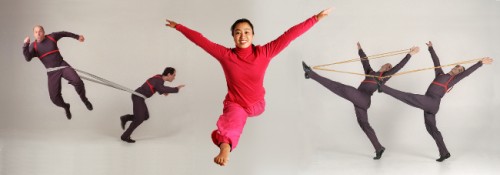
The Dr. Schaffer and Mr. Stern Dance Ensemble
The Signs of Discovery
What do mathematics and dance have in common? For years Karl Schaffer and Erik Stern have been revealing the surprising connections through highly physical, engaging choreography peppered with their unique brand of humor and entertaining audience interactions. From the stately “Shadowed Flight” to magical play with paper to Chinese legends of flight told with giant tangrams, the Dr. Schaffer and Mr. Stern Dance Ensemble addresses symmetry, number sense, the history of ideas and, ultimately, how we think.
Don’t miss their trio show The Signs of Discovery (which Karl and Erik perform along with company dancer Saki) as part of the Bridges Seoul 2014 conference at the Gwacheon National Science Museum.
Under the direction of Karl Schaffer and Erik Stern, the Dr. Schaffer and Mr. Stern Dance Ensemble has appeared at the prestigious Kennedy Center Imagination Celebration in Washington, D.C. and many other venues. Delighting audiences of all ages, the ensemble has received numerous national grants, and taught hundreds of workshops on how to connect dance and mathematics in the classroom. Their book, “MathDance with Dr. Schaffer and Mr. Stern,” is popular among arts and mathematics educators worldwide.
5. Poetry and Music Night (coordinated by Sarah Glaz and hosted by Mike Naylor), 6:30 – 8:00 PM at Eoullim Hall
Newton’s binomial is as beautiful as Venus de Milo.
What happens is that few people notice it.
Fernando Pessoa (as Álvaro de Campos)
translated from the Portuguese by Francisco Craveiro
The poetry event at Bridges Seoul is coordinated by Sarah Glaz, professor of mathematics at the University of Connecticut and poet, and hosted by Mike Naylor, professor of mathematics didactics at the NCME and artist. The poetry readings at Bridges feature poetry with strong links to mathematics and a wide range of poetic styles. The program starts with a movie where a number of invited poets read selections from their work, followed by an open microphone period where Bridges participants are invited to read their own mathematical poems. Selected poems from the reading will appear in the Bridges Poetry Anthology. Poets are encouraged to share more of their art and scholarship by submitting articles for talks or workshops, visual poems to the gallery, or poetry with animated or musical elements for the short movie festival.
Click here for more information about the program and the reading poets:
http://bridgesmathart.org/bridges-2014/2014-poetry-day/
6. Jardin Galerie’s Children and Youth Art Exhibit (curated by John Hiigli and Kristóf Fenyvesi), 10:30-6:30 PM
Eoulim Hall Lobby, Wall screen
Jardin Gallery and Experience Workshop presented a screened exhibition of mathematically inspired children artworks from all over the world submitted especially to Bridges 2014.



